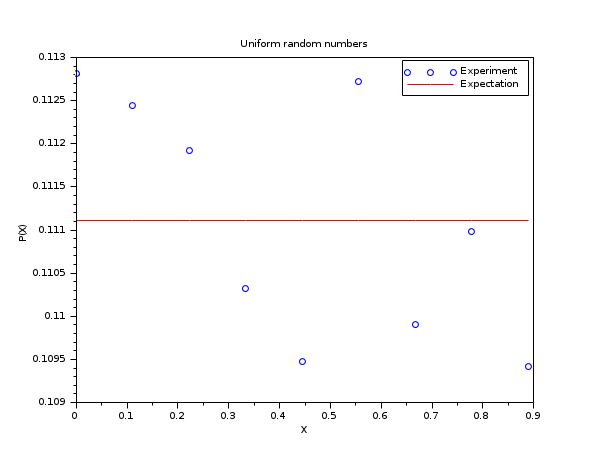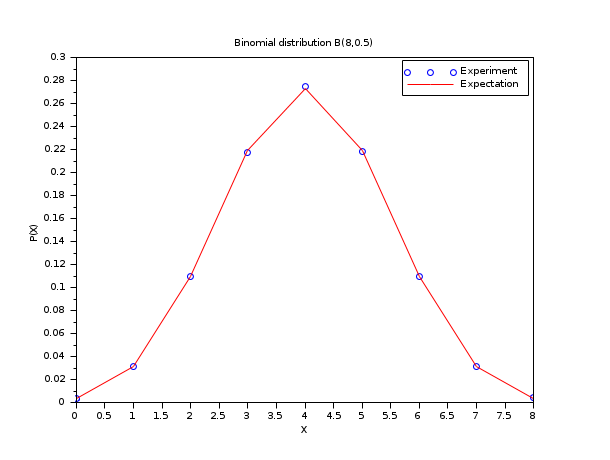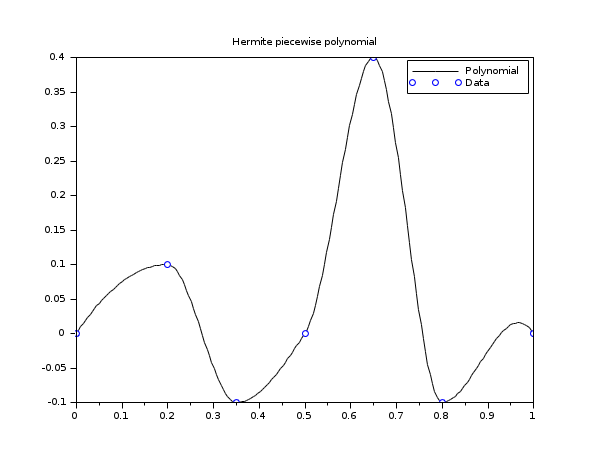Please note that the recommended version of Scilab is 2026.0.0. This page might be outdated.
See the recommended documentation of this function
dsearch
search in ordered sets
Calling Sequence
[ind, occ, info] = dsearch(X, s ) [ind, occ, info] = dsearch(X, s , ch )
Arguments
- X
a mx-by-nx matrix of doubles, the entries to locate.
- s
a n-by-1 or 1-by-n matrix of doubles, the intervals (if ch="c") or the set (if ch="d"). The values in s must be in strictly increasing order: s(1) < s(2) < ... < s(n)
- ch
a 1-by-1 matrix of strings, the type of search (default ch="c"). Available values are ch="c" or ch="d".
- ind
a mx-by-nx matrix of doubles. The location of the X values in the intervals or the set defined by
s.- occ
If ch="c", a (n-1)-by-1 or 1-by-(n-1) of doubles. If ch="d", a n-by-1 or 1-by-n of doubles. The number of entries from X in the intervals s.
- info
a 1-by-1 matrix of doubles. The number of X entries which are not in
s.
Description
This function locates the indices of the entries in X in the intervals or the set defined by s.
If ch="c" (default), we consider the
intervals I1 = [s(1), s(2)]
and Ik = (s(k), s(k+1)] for k=2,...,n-1.
Notice that the bounds of I1 are closed,
while the left bounds of I2, ..., In are
opened.
For each entry X(i),
we search the interval Ik which contains X(i), i.e. we search k such
that s(k)<X(i)<=s(k+1).
More precisely,
- ind(i)
is k such that
Ikcontains X(i) or 0 if X(i) is not in any intervalIk.- occ(k)
is the number of components of
Xwhich are inIk- info
is the number of components of
Xwhich are not in any intervalIk.
If ch="d", we consider the set {s(1),s(2),...,s(n)}.
For each X(i), search k such that X(i)=s(k).
More precisely,
- ind(i)
is k if X(i)=s(k) or 0 if X(i) is not in s.
- occ(k)
is the number of entries in X equal to s(k)
- info
is the number of entries in X which are not in the set {s(1),...,s(n)}.
The ch="c" option can be used to compute the empirical histogram of a function given a dataset. The ch="d" option can be used to compute the entries in X which are present in the set s.
Examples
In the following example, we consider 3 intervals I1=[5,11],
I2=(11,15] and I3=(15,20].
We are looking for the location of the entries of X=[11 13 1 7 5 2 9]
in these intervals.
[ind, occ, info] = dsearch([11 13 1 7 5 2 9], [5 11 15 20])
The previous example produces the following output.
-->[ind, occ, info] = dsearch([11 13 1 7 5 2 9], [5 11 15 20])
info =
2.
occ =
4. 1. 0.
ind =
1. 2. 0. 1. 1. 0. 1.
We now explain these results.
X(1)=11 is in the interval I1, hence ind(1)=1.
X(2)=13 is in the interval I2, hence ind(2)=2.
X(3)=1 is not in any interval, hence ind(3)=0.
X(4)=7 is in the interval I1, hence ind(4)=1.
X(5)=5 is in the interval I1, hence ind(5)=1.
X(6)=2 is not in any interval, hence ind(6)=0.
X(7)=9 is in the interval I1, hence ind(7)=1.
There are four X entries (5, 7, 9 and 11) in I1, hence occ(1)=4.
There is one X entry (i.e. 13) in I2, hence occ(2)=1.
There is no X entry in I3, hence occ(3)=0.
There are two X entries (i.e. 1, 2) which are not in any interval, hence info=2.
In the following example, we consider the set [5 11 15 20] and are searching the location of the X entries in this set.
[ind, occ, info] = dsearch([11 13 1 7 5 2 9], [5 11 15 20],"d" )
The previous example produces the following output.
-->[ind, occ, info] = dsearch([11 13 1 7 5 2 9], [5 11 15 20],"d" )
info =
5.
occ =
1. 1. 0. 0.
ind =
2. 0. 0. 0. 1. 0. 0.
The following is a detailed explanation for the previous results.
X(1)=11 is in the set
sat position #2, hence ind(1)=2.X(2)=13 is not in the set
s, hence ind(2)=0.X(3)=1 is not in the set
s, hence ind(3)=0.X(4)=7 is not in the set
s, hence ind(4)=0.X(5)=5 is in the set
sat position #1, hence ind(5)=1.X(6)=2 is not in the set
s, hence ind(6)=0.X(7)=9 is not in the set
s, hence ind(7)=0.There is one entry X (i.e. 5) equal to 5, hence occ(1)=1.
There is one entry X (i.e. 11) equal to 1, hence occ(2)=1.
There are no entries matching
s(3), hence occ(3)=0.There are no entries matching
s(4), hence occ(4)=0.There are five X entries (i.e. 13, 1, 7, 2, 9) which are not in the set
s, hence info=5.
The values in s must be in increasing order, whatever the
value of the ch option.
If this is not true, an error is generated, as in the following session.
-->dsearch([11 13 1 7 5 2 9], [2 1])
!--error 999
dsearch : the array s (arg 2) is not well ordered
-->dsearch([11 13 1 7 5 2 9], [2 1],"d")
!--error 999
dsearch : the array s (arg 2) is not well ordered
Advanced Examples
In the following example, we compare the empirical histogram of uniform random numbers in [0,1) with the uniform distribution function. To perform this comparison, we use the default search algorithm based on intervals (ch="c"). We generate X as a collection of m=50 000 uniform random numbers in the range [0,1). We consider the n=10 values equally equally spaced values in the [0,1] range and consider the associated intervals. Then we count the number of entries in X which fall in the intervals: this is the empirical histogram of the uniform distribution function. The expectation for occ/m is equal to 1/(n-1).
m = 50000 ; n = 10; X = grand(m,1,"def"); s = linspace(0,1,n)'; [ind, occ] = dsearch(X, s); e = 1/(n-1)*ones(1,n-1); scf() ; plot(s(1:n-1), occ/m,"bo"); plot(s(1:n-1), e,"r-"); legend(["Experiment","Expectation"]); xtitle("Uniform random numbers","X","P(X)");

In the following example, we compare the histogram of binomially distributed random numbers with the binomial probability distribution function B(N,p), with N=8 and p=0.5. To perform this comparison, we use the discrete search algorithm based on a set (ch="d").
N = 8 ; p = 0.5; m = 50000; X = grand(m,1,"bin",N,p); s = (0:N)'; [ind, occ] = dsearch(X, s, "d"); Pexp = occ/m; Pexa = binomial(p,N); scf() ; plot(s,Pexp,"bo"); plot(s,Pexa',"r-"); xtitle("Binomial distribution B(8,0.5)","X","P(X)"); legend(["Experiment","Expectation"]);

In the following example, we use piecewise Hermite polynomials to interpolate a dataset.
// define Hermite base functions function y=Ll(t, k, x) // Lagrange left on Ik y=(t-x(k+1))./(x(k)-x(k+1)) endfunction function y=Lr(t, k, x) // Lagrange right on Ik y=(t-x(k))./(x(k+1)-x(k)) endfunction function y=Hl(t, k, x) y=(1-2*(t-x(k))./(x(k)-x(k+1))).*Ll(t,k,x).^2 endfunction function y=Hr(t, k, x) y=(1-2*(t-x(k+1))./(x(k+1)-x(k))).*Lr(t,k,x).^2 endfunction function y=Kl(t, k, x) y=(t-x(k)).*Ll(t,k,x).^2 endfunction function y=Kr(t, k, x) y=(t-x(k+1)).*Lr(t,k,x).^2 endfunction x = [0 ; 0.2 ; 0.35 ; 0.5 ; 0.65 ; 0.8 ; 1]; y = [0 ; 0.1 ;-0.1 ; 0 ; 0.4 ;-0.1 ; 0]; d = [1 ; 0 ; 0 ; 1 ; 0 ; 0 ; -1]; X = linspace(0, 1, 200)'; ind = dsearch(X, x); // plot the curve Y = y(ind).*Hl(X,ind) + y(ind+1).*Hr(X,ind) + d(ind).*Kl(X,ind) + d(ind+1).*Kr(X,ind); scf(); plot(X,Y,"k-"); plot(x,y,"bo") xtitle("Hermite piecewise polynomial"); legend(["Polynomial","Data"]); // NOTE : it can be verified by adding these ones : // YY = interp(X,x,y,d); plot2d(X,YY,3,"000")

See Also
| Report an issue | ||
| << lex_sort | Chercher et trier | vectorfind >> |